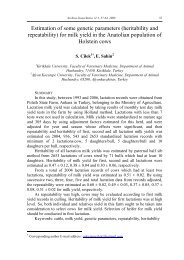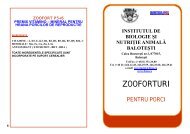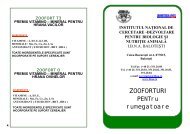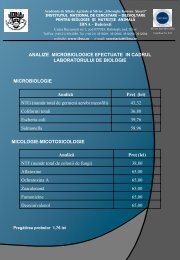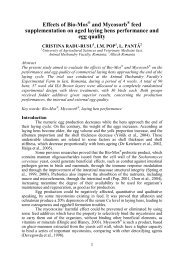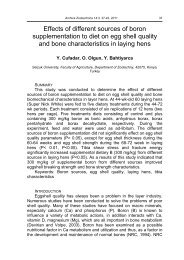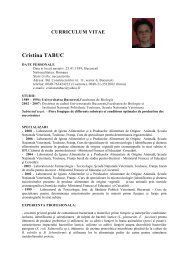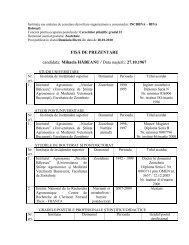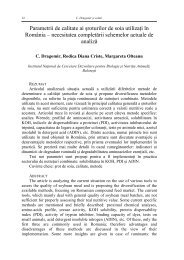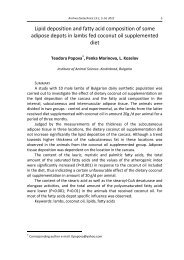(Coturnix coturnix japonica) during rearing and laying periods - IBNA
(Coturnix coturnix japonica) during rearing and laying periods - IBNA
(Coturnix coturnix japonica) during rearing and laying periods - IBNA
You also want an ePaper? Increase the reach of your titles
YUMPU automatically turns print PDFs into web optimized ePapers that Google loves.
76<br />
M. M. Nagharchi et al.<br />
The effects of fermented <strong>and</strong> dried whey powder on<br />
performance <strong>and</strong> nutrient digestibility in broilers<br />
M. M. Nagharchi 1† , M. G. Jouybari 1 , V. Rezaeipour 1 , N. Dehpanah 2<br />
1 Department of Animal Science, Islamic Azad University Ghaemshahr Branch.Iran<br />
2 Department of Animal Science, Agricultural University of Sari. Iran<br />
SUMMARY<br />
In this experiment, effects of fermented <strong>and</strong> dried whey powder on<br />
performance, protein <strong>and</strong> fat digestibility were investigated. The experiment<br />
included 280 Ross broilers from 1 to 42 days of age. Birds were r<strong>and</strong>omly<br />
allocated to 7 treatments, with 4 replicates of 10 birds in each. Treatments<br />
include T1.Negative Control (basal diet, with no added whey); T2 – Negative<br />
Control + 1/5% dried whey powder, T3 – Negative Control + 3% dried whey<br />
powder, T4 – Negative Control + 4/5% dried whey powder, T5- Negative<br />
control + 1/5% fermented whey, T6- Negative control + 3% fermented whey<br />
<strong>and</strong> T7- Negative control + 4/5% fermented whey. All treatments received<br />
whey <strong>during</strong> whole period of <strong>rearing</strong>. The results obtained in this experiment<br />
showed that the both kinds of whey significantly increased body weight gain<br />
(P
Analele <strong>IBNA</strong> vol. 26, 2010 77<br />
particular is improved. However the use of growth-promoting antibiotics is<br />
being placed under more <strong>and</strong> more Pressure as consumers increasingly fear that<br />
their use in feed rations of productive live stocks leads to the formation of<br />
resistance against bacteria which are pathogenic to humans (Langhout, 2000).<br />
Some prebiotics are an alternative to antibiotic to be used exclusively as a<br />
growth stimulant <strong>and</strong> for improvement of the feed conversion rate in farm<br />
animals (Esteive et al., 1997).A prebiotic compound was defined by Gibson <strong>and</strong><br />
Roberfroid(1995) as " a nondigestible feed ingredient that beneficially affect the<br />
host by selectively stimulating the grows <strong>and</strong>/or activity one or a limited<br />
number of bacteria in the colon <strong>and</strong> then improves got health. Whey can be used<br />
as a prebiotic. Lactose that is a major compound of whey, is a prebiotic but<br />
since poultry are lacking lactase (harms et al., 1997), lactose can not be digested<br />
or absorbed efficiently <strong>and</strong> almost reaches to ceca <strong>and</strong> large intestine intact<br />
(Langhout, 1989). In ceca, the population of useful bacteria likes lactobacillus<br />
<strong>and</strong> bifidobacteria (Zigger, 2000) increases <strong>and</strong> the pH of the GIT, due to<br />
increasing production of volatile fatty acids (VFAs), decreases. Therefore the<br />
environment of GIT becomes unsuitable for the activity <strong>and</strong> proliferation of<br />
pathogens like salmonella. On the other h<strong>and</strong>, a small decreasing in intestinal<br />
pH can improve nutrient digestibility. Studies with broiler chicks were indicated<br />
a positive response to dietary supplementation of prebiotic on nutrient<br />
digestibility (Biggs <strong>and</strong> parsons, 2007; Biggs, Parsons <strong>and</strong> Fahey, 2007).<br />
Kermanshahi <strong>and</strong> Rostami observed significant improvements in positive<br />
bacteria population for broiler chicks fed dried whey powder as a prebiotic. The<br />
review of literature showed that, fermentation of dried whey powder in the GIT<br />
produce CO2 that can be harmful for broiler. Fermented whey is a kind of whey<br />
that is fermented <strong>during</strong> producing process <strong>and</strong> can decrease the gas production<br />
in the intestine. Because of this, in the present study, we used two kinds of<br />
whey (fermented <strong>and</strong> dried whey powder) as new prebiotic on performance <strong>and</strong><br />
nutrient digestibility.<br />
MATERIAL AND METHODS<br />
In this study, totally 280, day-old Ross 308 chicks were used. The chicks<br />
were divided into 7 groups, 6 treatment groups <strong>and</strong> a control group, with 10<br />
chicks in each. Each group was housed separately in individual. Forty two<br />
stainless steel cages 40 × 65 × 98 cm were used to accommodate 10 chicks per<br />
m 2 . Plastic holed flooring was used as bedding. The chicks were fed st<strong>and</strong>ard<br />
starter (from 1 to 21 d), <strong>and</strong> grower (from 22 to 42 d) diets according to NRC<br />
(1994) (Table 1 <strong>and</strong> 2). Groups were r<strong>and</strong>omly assigned to following treatment<br />
groups, (1) Basal diet-no additives (control), (2) Basal diet + 1.5 % dried whey<br />
powder, (3) Basal diet + 3 % dried whey powder, (4) Basal diet + 4.5 % dried<br />
whey powder, (5) Basal diet + 1.5% fermented whey, (6) Basal diet + 3%<br />
fermented whey <strong>and</strong> (7) Basal diet + 4.5% fermented diet. Each experimental<br />
group was fed ad libitum with its own diet for 42 d. The temperature of the
78<br />
M. M. Nagharchi et al.<br />
room with continuous lighting was maintained at 33˚ C initially, <strong>and</strong> reduced by<br />
3˚ C/wk until reached 21˚ C, at which the room temperature was maintained for<br />
the end of experiment. Light was provided 24 h a day. Body weight gain, feed<br />
consumption <strong>and</strong> feed efficiency (feed: gain) were checked weekly. At the end<br />
of the study period (day 42), one bird was r<strong>and</strong>omly selected from each<br />
replicate of each treatment group <strong>and</strong> moved to metabolic cage <strong>and</strong> reared for 7<br />
days. During this period, chicks were fed by their diet with 0/3% chromic oxide.<br />
3 days of the beginning of this period was as adaptation period <strong>and</strong> after than<br />
fecal samples were collected daily. At the end of this period (7 days), all chicks<br />
were slaughtered <strong>and</strong> ileum (from Meckel’s diverticulum to 1 cm above<br />
ileocaecal junction) samples were collected. All of the samples weighted in<br />
aluminum foil <strong>and</strong> were dried in an oven at 60˚ C. After 48 hours, they ground<br />
in a mixer <strong>and</strong> heated in an oven at 600˚ C to remove organic matter. The<br />
grounded samples were used to measurement quantities of protein, fat <strong>and</strong> dry<br />
matter. The protein content (N×6.25) of diet <strong>and</strong> individual samples of excreta<br />
was determined by the Kjeldahl method after acid digestion. Ileum <strong>and</strong> fecal<br />
chromium (Cr) were analyzed by the procedure described by Fenton <strong>and</strong> Fenton<br />
(1979), using spectrophotometry. Fat <strong>and</strong> protein digestibility were calculated<br />
using the following formula:<br />
100% - [100% × (Cr concentration in feed ÷Cr concentration in excreta) ×<br />
(fat or protein concentration in excreta ÷ fat or protein concentration in feed)]<br />
Table 1: Starter diet composition<br />
Ingredients Diet Diet with<br />
(%) without 1.5%<br />
whey dried<br />
whey<br />
Corn 58.0<br />
Soybean 37.9<br />
Fat 0<br />
DCP 1.65<br />
CaCO3 1.31<br />
Salt 0.2<br />
Methionine 0.2<br />
Lysine 0.04<br />
Additive 0.55<br />
Sodium bi 0.1<br />
carbonate<br />
Whey 0<br />
Calculated analysis<br />
ME kcal/kg) 2879<br />
CP %<br />
CA %<br />
AP%<br />
MET %<br />
LYZ %<br />
21.81<br />
0.95<br />
0.47<br />
0.55<br />
1.3<br />
57.1<br />
37.4<br />
0<br />
1.61<br />
1.3<br />
0.2<br />
0.2<br />
0.04<br />
0.55<br />
0.1<br />
1.5 %<br />
2864<br />
21.69<br />
0.95<br />
0.47<br />
0.55<br />
1.3<br />
Diet with<br />
3% dried<br />
whey<br />
56.1<br />
37.0<br />
0<br />
1.56<br />
1.3<br />
0.2<br />
0.2<br />
0.04<br />
0.55<br />
0.1<br />
3%<br />
2850<br />
21.59<br />
0.95<br />
0.47<br />
0.55<br />
1.3<br />
Diet with<br />
4.5% dried<br />
whey<br />
54.9<br />
36.6<br />
0<br />
1.52<br />
1.3<br />
0.2<br />
0.2<br />
0.04<br />
0.55<br />
0.1<br />
4.5%<br />
2840<br />
21.51<br />
0.95<br />
0.47<br />
0.55<br />
1.3<br />
Diet with<br />
1.5%<br />
fermented<br />
whey<br />
56.9<br />
37.6<br />
0<br />
1.63<br />
1.29<br />
0.2<br />
0.2<br />
0.04<br />
0.55<br />
0.1<br />
1.5%<br />
2855<br />
21.63<br />
0.95<br />
0.47<br />
0.55<br />
1.3<br />
Diet with<br />
3%<br />
fermented<br />
whey<br />
55.8<br />
37.2<br />
0<br />
1.6<br />
1.28<br />
0.2<br />
0.2<br />
0.04<br />
0.55<br />
0.1<br />
3%<br />
2831<br />
21.45<br />
0.95<br />
0.47<br />
0.55<br />
1.3<br />
Diet with<br />
4.5%<br />
fermented<br />
whey<br />
53.6<br />
37.5<br />
0<br />
1.58<br />
1.26<br />
0.2<br />
0.2<br />
0.04<br />
0.55<br />
0.1<br />
4.5%<br />
2830<br />
21.43<br />
0.95<br />
0.47<br />
0.55<br />
1.3
Table 2: Grower Diet composition<br />
Ingredients Diet Diet with Diet with<br />
(%) without 1.5% 3% dried<br />
whey dried whey<br />
whey<br />
Corn 65/2 63/6 62/6<br />
Soybean 30/1 30/1 29/8<br />
Fat 0/29 0/6 0/6<br />
DCP 1/58 1/81 1/76<br />
CaCO3 1/38 1/38 1/38<br />
Salt 0/24 1/9 0/1<br />
Methionine 0/23 0/23 0/23<br />
Lysine 0/08 0/06 0<br />
Additive 0/55 0/55 0/55<br />
Sodium bi 0 0/06 0/29<br />
carbonate<br />
Whey 0 1.5 % 3%<br />
Calculated analysis<br />
ME kcal/kg) 2950 2950 2940<br />
CP %<br />
CA %<br />
AP%<br />
MET %<br />
LYZ %<br />
19.03<br />
1.1<br />
0.85<br />
0.55<br />
1.1<br />
19.03<br />
1.1<br />
0.85<br />
0.55<br />
1.1<br />
Analele <strong>IBNA</strong> vol. 26, 2010 79<br />
18.96<br />
1.1<br />
0.5<br />
0.55<br />
1.05<br />
Diet with<br />
4.5% dried<br />
whey<br />
61/5<br />
24/9<br />
0/6<br />
1/72<br />
1/37<br />
0/14<br />
0/23<br />
0<br />
0/55<br />
0/09<br />
4.5%<br />
2920<br />
18.83<br />
1.1<br />
0.5<br />
0.55<br />
1.05<br />
Diet with<br />
1.5%<br />
fermented<br />
whey<br />
62/9<br />
30/5<br />
0/82<br />
1/81<br />
1/38<br />
0/23<br />
0/23<br />
0/05<br />
0/55<br />
0<br />
1.5%<br />
2950<br />
19.03<br />
1.1<br />
0.85<br />
0.55<br />
1.1<br />
Diet with<br />
3%<br />
fermented<br />
whey<br />
61/2<br />
30/5<br />
1/08<br />
1/76<br />
1/38<br />
0/16<br />
0/23<br />
0/0<br />
0/55<br />
0/08<br />
3%<br />
2940<br />
18.96<br />
1.1<br />
0.5<br />
0.55<br />
1.07<br />
Diet with<br />
4.5%<br />
fermented<br />
whey<br />
58/9<br />
30/9<br />
1/62<br />
1/71<br />
1/37<br />
0/16<br />
0/23<br />
0<br />
0/55<br />
0/06<br />
4.5%<br />
2940<br />
18.96<br />
1.1<br />
0.5<br />
0.55<br />
1.09<br />
Statistical analysis<br />
The data obtained were analyzed by SAS (1990) with a General Linear<br />
Models procedure for ANOVA, for each experiment. Differences between<br />
means were analyzed with Duncan’s multiple gaps test. The significant<br />
difference statements were based on the possibility p0.05), but there were significantly differences between treatments<br />
about weight gain <strong>during</strong> starter (P>0.05). As a result, the best feed conversion<br />
ratios were found for the groups in which the broilers were fed the diet<br />
containing both kinds of whey in starter <strong>and</strong> grower. From 1 to 42 days of age,<br />
feed intake was higher in broilers fed the basal diet (negative control) as<br />
compared with those fed the diet with prebiotic (Table2). Also in this period,<br />
treatments affected weight gain, <strong>and</strong> treatments that consumed the feed<br />
containing prebiotic in total period <strong>and</strong> in starter <strong>and</strong> grower presented better<br />
feed conversion ratios as compared to basal diet. When the entire <strong>rearing</strong> period<br />
was evaluated, feed intake of broilers fed prebiotic was significantly lower than<br />
in the basal diet except T4 (4.5% dried whey powder) <strong>and</strong> T5 (1.5% fermented
80<br />
M. M. Nagharchi et al.<br />
whey). It is also evidenced that the best feed conversion ratio in this period was<br />
presented by the broilers fed the diet with prebiotic. At the end of experiment,<br />
results about nutrient digestibility shown that treatments significantly affected<br />
on protein <strong>and</strong> fat digestibility (P>0.05). Significantly differences were<br />
observed in treatment that consumed the feed containing prebiotic (P>0.05),<br />
specially about T6 (3% fermented whey) that have had highest digestibility for<br />
both fat <strong>and</strong> protein in faecal <strong>and</strong> ileum. In all treatment that was fed with whey,<br />
nutrient digestibility in faecal was higher than basal diet (P>0.05).<br />
DISCUSSIONS<br />
The addition of whey as a prebiotic to diets may influence broiler weight<br />
gain (Jones & Ricke, 2005). However, the main objective of using these<br />
compounds in broiler diets is to improve their feed conversion ratio (Dibner &<br />
Richards, 2005), as was observed in this study. The mechanism that explains the<br />
action of prebiotics is focused on gastrointestinal tract, as most of these<br />
products are not absorbed, <strong>and</strong> are not efficient as growth promoters in germfree<br />
animals (Coates et al., 1955; Coates et al., 1963). Therefore, it maybe<br />
speculated that there is a strong interaction between prebiotics <strong>and</strong> the intestinal<br />
micro flora. The improvement in performance (feed conversion ratio) of birds<br />
fed with diets containing the tested prebiotic shows that the use of these<br />
products is a feasible alternative to antibiotics used as growth promoters.<br />
Similar results were also found by Maiorka et al. (2001), Pelicano et al. (2004),<br />
<strong>and</strong> Pelícia et al. (2004). Wolf et al (1998) hypothesized that when a<br />
fermentable carbohydrate reached the hind gut, the bacterial mass in the hind<br />
gut increased due to increased energy (the prebiotic ) reaching the hind gut.<br />
When carbohydrate are limited in the hind gut, bacteria increase fermentation of<br />
amino acids to short-chain fatty acids <strong>and</strong> ammonia to obtain energy (Russell et<br />
al., 1991); however, when energy is sufficient, the luminal concentration of<br />
nitrogenous compounds decreases <strong>and</strong> the concentration of fecal nitrogen<br />
(bacterial mass) increases (Cummings et al 1987). The latter caused a decrease<br />
in amino acid digestibility, particularly when high levels of an oligosaccharide<br />
were fed. On the other h<strong>and</strong>, Xu et al (2003), evaluated the effect of a prebiotic<br />
in the name of fructooligosaccharids (FOS), on small intestinal digestive<br />
enzyme activity of total protease, amylase, <strong>and</strong> lipase in 49-d-old broilers <strong>and</strong><br />
fund that these enzymes activity were improved by 27, 75 <strong>and</strong> 32%<br />
respectively, compared with unsupplemented broilers when FOS was<br />
supplemented at 4 g/kg. thus, the improvement in protein <strong>and</strong> fat digestibility in<br />
current study may have been due to increase in proteolytic <strong>and</strong> lipase activity in<br />
the small intestine. Positive effects of oligosaccharides (prebiotic) on nutrient<br />
digestibility were observed by Wu et al. (1999) <strong>and</strong> Batal & Parsons, (2002).<br />
There are some hypothetical mechanisms that can explain the improved nutrient<br />
digestibility in fermented whey fed chickens. One of these mechanisms is the<br />
acidifying effect of the fermented whey in the interior part of the
Analele <strong>IBNA</strong> vol. 26, 2010 81<br />
gastrointestinal tract. Because the pH of the fermented whey is lower than the<br />
pH generally observed in the small intestine (Heres et al, 2003), the fermented<br />
whey lowers the small intestine pH. It was shown that a normal decrease in<br />
small intestine pH can improve nutrient digestibility as was shown in current<br />
study.<br />
Table 2 - Feed intake (FI), weight gain (WG), feed conversion ratio (FCR), faecal <strong>and</strong><br />
illeal protein <strong>and</strong> fat digestibility of broilers fed prebiotic from 1 to 42 days of age.<br />
Treatments/factors 1 2 3 4 5 6 7 SEM<br />
Starter 928 931 916 931 933 911 932 8.46<br />
FI Grower 3189 3172 3097 3192 3189 3047 3128 30.62<br />
Total 4114 4068 4014 4123 4123 3959 4061 103.3<br />
Starter 671 b 715 ab 706 ab 735 a 724 ab 688 ab 719 ab 8.46<br />
WG Grower 1797 1804 1753 1890 1890 1779 1847 34.8<br />
Total 2468 2519 2459 2625 2611 2467 2566 55.5<br />
Starter 1.38 a 1.30 b 1.30 b 1.26 b 1.28 b 1.32 b 1.29 b 0.03<br />
FCR Grower 1.77 1.74 1.76 1.69 1.68 1.71 1.69 0.03<br />
Total 1.66 1.61 1.63 1.57 1.57 1.60 1.58 0.03<br />
Fecal protein 71.55 c 76.95 a 76.36 a 78.33 a 77.99 a 84.49 a 78.21 b 0.7<br />
digestibility %<br />
Fecal fat<br />
73.36 d 81.82 c 83.06 bc 84.02 b 82.97 bc 87.36 a 86.52 a 0.62<br />
digestibility%<br />
Ileal protein 67.55 d 72.48 bcd 73.38 bc 70.99 cd 72.51 bcd 79.78 a 71.71 ab 0.87<br />
digestibility %<br />
Ileal fat<br />
67.05 d 73.98 c 75.14 c 79.41 ab 76.65 bc 83.42 c 82.78 ab 0.99<br />
digestibility%<br />
Means without a common superscripts in per row are significantly different (P
82<br />
M. M. Nagharchi et al.<br />
Dibner JJ, Richards JD. 2005. Antibiotic growth promoters in agriculture:<br />
History <strong>and</strong> mode action. Poultry Science; 84:634-643.<br />
Esteive, G. E., J. Brufau <strong>and</strong> V. A. M. A. K. Perez, 1997. Bioefficacy of enzyme<br />
preparations containing betaglucanese <strong>and</strong> xylanase activities in broiler diets<br />
based on barley or heat, in combination with flavomycin. Poultry Science.<br />
76: 1728-1737.<br />
Fenton, T.W. <strong>and</strong> M. Fenton, 1979. Determination of chromic oxide in feed <strong>and</strong><br />
feces. Canadian Journal of Animal Science.58: 631-634.<br />
Gibson, G. R, <strong>and</strong> M. B. Roberfroid. 1995. Dietary modulation of the human<br />
colonic microbiota-introduccing the concept of prebiotics. Journal of<br />
Nutrition.125:1401-1412<br />
Harms, R. H, B. L. Damron <strong>and</strong> C. F. Simpson. 1997. Effect of wet litter <strong>and</strong><br />
supplemental biotin <strong>and</strong>/or whey on the production of feet pad dermatitis in<br />
broilers. Poultry science. 56:291-299<br />
Kermanshahi H, <strong>and</strong> H. Rostami. 2006. Influence of supplemental dried whey<br />
on broiler performance <strong>and</strong> cecal frola. International journal of poultry<br />
science. 5(6):538-543<br />
Langhout, P., 2000. New additives for broiler chickens. Feed Mix. 24-27.<br />
Maiorka A, Santin E, Sugeta S, Almeida JG, Macari M. 2001. Utilização de<br />
prebióticos, probióticos ou simbióticos em dietas para frangos. Revista<br />
Brasileira de Ciência Avícola; 3:75-82.<br />
Pelicano ERL, Souza PA, Souza HBA, Leonel FR, Zeola NMBL, Boiago MM.<br />
2004. Productive traits of broiler chickens fed diets containing different<br />
growth promoters. Brazilian Journal of Poultry Science; 6:177-182.<br />
Pelícia K, Mendes AA, Saldanha ESPB, Pizzolante CC, Takahashi SE, Moreira<br />
J, Garcia RG, Quinteiro RR, Paz ICLA, Komiyama CM. 2004. Use of<br />
prebiotics <strong>and</strong> probiotics of bacterial <strong>and</strong> yeast origin for freerange broiler<br />
chickens. British Journal of Poultry Science; 6:163-169.<br />
Russell, J. B, R. Onodera, <strong>and</strong> T. Hino. 1991. Ruminal protein fermentation:new<br />
perspectives on previous contradictions. Academic pres, New York, NY.<br />
681-697<br />
Wolf, B. W, J. L. Firkins <strong>and</strong> X. Zhang. 1998. Varying dietary concentrations of<br />
fructooligosaccharide affect apparent absorption <strong>and</strong> balance of minerals in<br />
growing rats. Nutriton Resource. 17:1791-1806<br />
Wu, T. X,. X. Y. Dai <strong>and</strong> L. Y. Wu. 1999. effects of fructooligosaccharide on<br />
the broiler production. Acta agric. Zhejiangensis 11:85-87<br />
Xu, Z. R, C. H. Hu, M. S. Xia, X. A. Zhan, <strong>and</strong> M. Q. Wang. 2003. Effects of<br />
dietary fructooligosaccharide on digestive enzyme activities, intestinal<br />
microflora <strong>and</strong> morphology of male broilers. Poultry Science. 82:1030-1036<br />
Ziggers, D. 2000. A new prebiotic derived from whey. Feed tec. 5:34-36


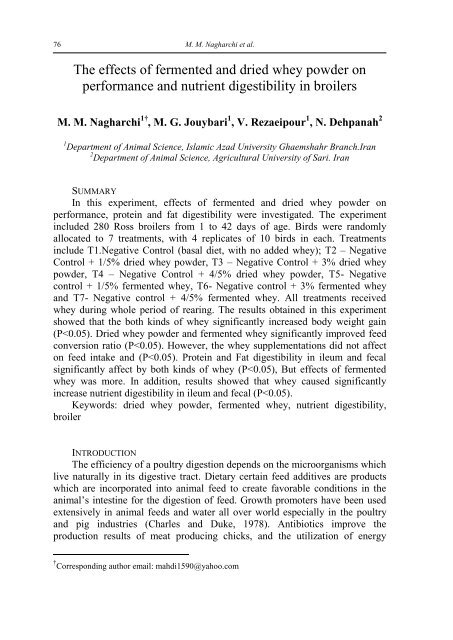
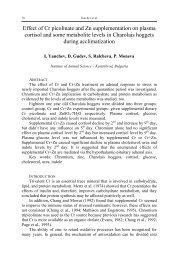
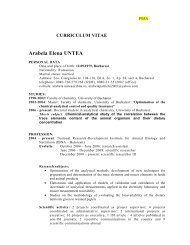
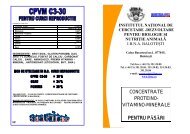
![( ) ( ) [ ] ( ) ( ) ( ) ( ) [ ]n ( ) ( ) [ ]n](https://img.yumpu.com/22443310/1/184x260/-n-n.jpg?quality=85)
